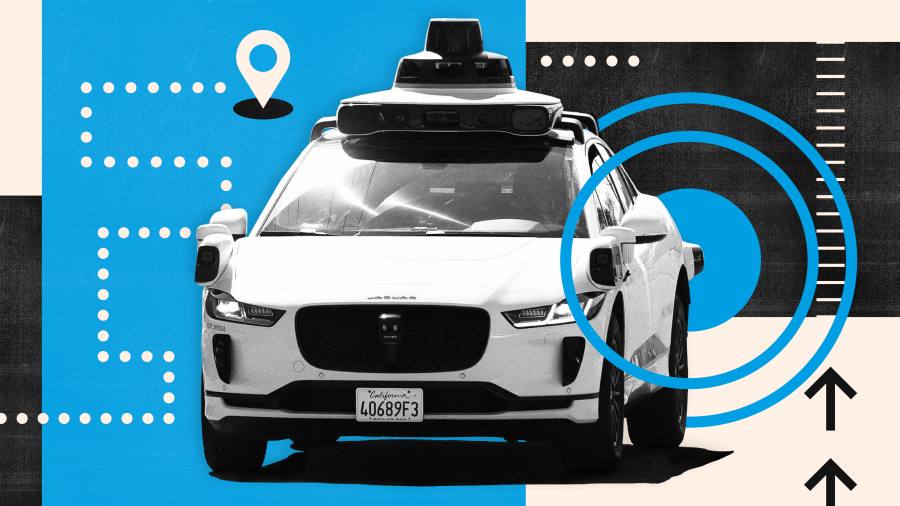
Receive free Driverless vehicles updates
We’ll send you a myFT Daily Digest email rounding up the latest Driverless vehicles news every morning.
For the past two weeks, I’ve been zipping around San Francisco in driverless taxis, transfixed by the way they can navigate busy streets so smoothly. If you came to meet me in the city, there was a high chance I’d ask you to come with me for a ride. That was until I got into a car that had a meltdown, came to a standstill and wouldn’t immediately open its doors.
There is a saying in tech that if you are not paying for a product, then you are the product. In the case of driverless cars, you are not the product, you are the guinea pig. San Francisco is being used as a living laboratory. What started with a few vehicles circling Golden Gate Park with safety drivers has expanded this year into hundreds of completely empty vehicles across multiple neighbourhoods. If companies have their way, more are coming.
Waymo, owned by Google’s parent company Alphabet, and General Motors’ Cruise both want to offer 24-hour taxi services.
For now, permissions are limited. Waymo cannot charge for rides. Cruise can charge but only at night in certain parts of the city. A vote to consider Waymo’s request to collect fares and Cruise’s application to run a daytime service has been postponed to mid-July.
San Francisco’s acceptance of driverless cars seems at odds with the city’s attitude towards other attempts to upend transportation. In 2018, for example, it banned electric scooter companies from operating without permits. It has stopped rideshare companies from driving along parts of the central Market Street.
So why is the city so welcoming to driverless cars? It turns out the city doesn’t have much say over the matter. Companies got the go-ahead from the state California Public Utilities Commission and the department of motor vehicles.
Some city agencies are deeply unhappy about the situation. The San Francisco Municipal Transportation Agency, which oversees street transport, has called for the rollout to slow down. Stephen Chun, deputy spokesperson, said the city supported the technology but was cautious about the rise in traffic incidents. “We’re excited to be the test city but this is still in development,” he said. “We’re not shooting the tech down, we’re requesting incremental expansion.”
So far, traffic incidents have been more annoying than alarming. There are reports of driverless cars blocking lanes, for example. One Cruise car got in the way of firefighters. But there has been no particular pushback from residents. Both Cruise and Waymo have long waiting lists. Although of course, the passengers who sign up aren’t the only ones taking part in this experiment. Pedestrians, cyclists and other drivers are all in it too, whether they realise it or not.
I thought of this while trying to cross a road where an empty Waymo car was sitting in the middle of a pedestrian crossing. There was no driver to make eye contact with, so I had no idea if the car would stay still or try to roll backwards. In the end, I decided to steer clear until it had driven away.
Waymo says that if I had walked behind the car on that crossing it would have sensed I was there and remained still. Avoiding collisions is the car’s guiding principle. If it is safer to sit on a pedestrian crossing it will do so. It also says that cars have gesturing perception, meaning they are able to follow instructions from someone asking them to stop or waving them forward.
I had planned to end this column with an enthusiastic vote of support for robotaxis. Their ability to sense and avoid obstacles via radar, lidar and cameras is impressive. They don’t speed, they stop at crossings and they slow down for pedestrians. Eliminating human error would undoubtedly make roads safer.
Then came that last ride. Late on Thursday evening, I called a driverless Cruise car to take a friend who had never been in one before and had spent the evening listening to me rhapsodise over them. A few minutes into the journey the car suddenly changed course. What should have taken six minutes now showed as 24. It then tried to move from one lane to another before coming to a stop, indicator flashing. A line of cars honked their horns behind us but the car wouldn’t budge. Realising there was nothing we could do, we tried to end the ride but the doors remained locked.
It was only for a few seconds. But those few seconds were long enough to remember the high stakes involved in technology that is still in development. Cruise points to its safety record and the 2mn miles driven without serious injury or fatality. But it will still be a while before I climb back into a car that doesn’t have a driver behind the wheel.